-
Car Reviews
- All reviews
- Midsize SUVs
- Small cars
- Utes
- Small SUVs
- Large SUVs
- Large cars
- Sports SUVs
- Sports cars
- Vans
Latest reviews
- Car News
-
Car Comparisons
Latest comparisons
- Chasing Deals
When Mitsubishi’s Outlander launched in 2003, there weren’t many medium-sized SUVs to choose from: Mitsubishi were well ahead of the curve. Fast forward 14 years, though, and there are more than fifteen different mid-size crossovers to choose from. Competition is tough: today’s Outlander competes with big names like the Mazda CX-5 and Volkswagen Tiguan, and more than 109,000 medium SUVs already sold this year – up twenty per cent on this time last year. But the 2017 Mitsubishi Outlander PHEV is a pretty unique offering: it’s the only mainstream mid-size SUV that offers genuine electric range, thanks to its plug-in hybrid architecture that pairs a battery worth 54 kilometres in the city to a small two-litre petrol engine for when the electric stuff is depleted.
But first, a bit of history. The Outlander PHEV is just the latest iteration of Mitsubishi’s middle child, but they’ve never been as popular in Australia as they perhaps should have been. The first-generation Outlander – dubbed Airtrek in some overseas markets with an available Turbo R model that used the Evo 7’s 2.0-litre turbo engine – was a car that barely fired up the sales charts. Even the much more handsome Australian-designed facelift in 2005 did it no sales favours. Moving into its second iteration of 2007, the Outlander became larger and more stylish, as well as offering a 3.0-litre V6 petrol engine and most significant of all, seven seats for the first time.
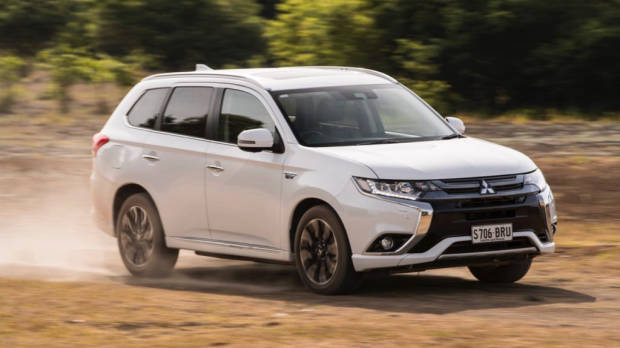
This third-generation Outlander that you see here was originally launched in 2013, though a comprehensive facelift arrived after less than two years to address complaints about bland looks, iffy interior quality, and questionable value. What resulted was a significantly improved Outlander, and the facelift was the antidote necessary to get sales moving. The 12,935 Outlanders moved in 2017 is up a massive 46 per cent on last year. While the PHEV represents a relatively small part of the sales pie, the electric Outlander is a ‘halo’ car for Mitsubishi’s range.
On our recent trip to Outback Australia to drive Mitsubishi’s entire SUV range, both a conventional Outlander 2.2-litre diesel and the Outlander PHEV were available to sample. Before getting to the highlight that was the PHEV, a quick spin with the diesel reminded of its core strength – the 2.2-litre turbo diesel powerplant has plenty of grunt and is relatively refined. And at $47,500, the highest-specification non-PHEV Outlander, the Exceed diesel, looks like a bargain compared to many $50,000+ flagship medium SUVs. For 2017, the flagship diesel has added an all-new infotainment system, automatic high beam, blind-spot monitoring, a 360-degree camera to ease parking, and higher-speed autonomous emergency braking.
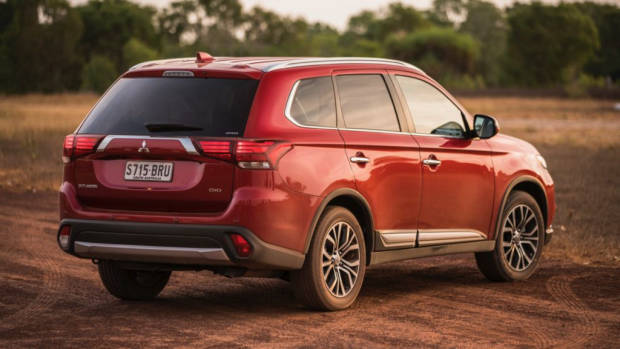
The highest-specification non-electric Outlander, the Exceed diesel.
All of that equipment has been added to the Outlander PHEV Exceed, too – the higher of the PHEV’s two specification levels. Priced at $55,490, the precious electric range does mean shelling out an additional $7,990 on top of the diesel oiler, but if you’re constantly in city traffic, that could make sense to you – do the maths. The PHEV, too, makes you feel good at low speeds, gliding along silently and spewing out zero emissions.
The $55,490 Outlander PHEV was the real surprise of the Outback Drive Event for me. While most PHEV owners won’t venture outside of the city because they don’t need to or they think their plug-in hybrid is too precious for rural use, our experience with the car proves that they needn’t think that way. While I was genuinely surprised at the off-road ability of the standard Outlander, the Outlander PHEV with its lesser ground clearance thanks to lower-hanging rear batteries, more eco-friendly tyres and that its rear differential is powered by electricity instead of a physical connection with the front was more of a concern to me.
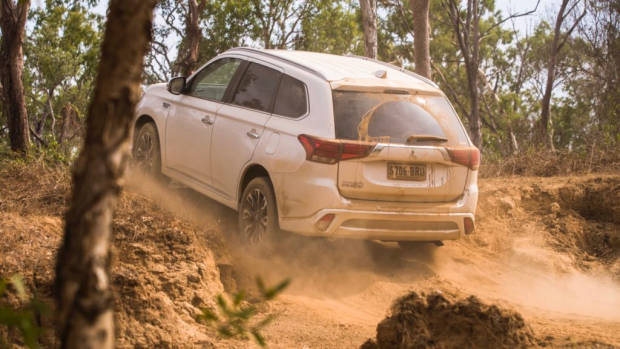
However, the PHEV travelled everywhere that the standard Outlander was able to travel, it quickly became apparent that this car is not just an urban dweller. The Outlander PHEV is particularly impressive because it’s billed as the future of the Japanese company, and indeed the automotive industry in general. It uses a 2.0-litre petrol engine at the front, and a pair of electric motors driving the rear wheels – the battery pack lies underneath the boot floor instead of the seven seats of the standard Outlander. Total output is claimed at 89kW/190Nm for the petrol engine, and 60kW/137Nm and 60kW/195Nm for the electric motors, and its official ADR combined cycle fuel economy claim is just 1.7L/100km.
The driving experience of the Outlander PHEV is perhaps the most interesting thing about it. Mitsubishi claims a maximum electric-only range of 54km though that is in the city where plug-in ports, albeit still rare in 2017, are much more common than in the Australian outback. To my surprise, the PHEV was able to complete around 10km of electric-only driving per day, having conserved energy from its regenerative braking system to charge its batteries. When in hybrid mode, the electric motor and petrol engine work together to provide the best possible fuel economy and performance in any given situation – in reality, its a very seamless transition from electric to petrol power, one you barely notice when the air-conditioning on full blast, as is required in the 40 degree plus weather we encountered.
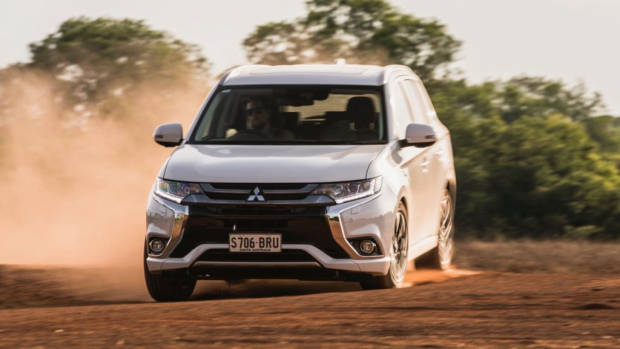
Off-road, the only liability to the PHEV’s overall ability was its ground clearance – the lower-hanging rear battery pack compared to the standard Outlander meant that most aspects of off-road driving required more careful consideration. Even driving along muddy tracks had constant grass contact. I never thought that the PHEV would be fun however – thanks to Mitsubishi’s S-AWC system derived from the last Lancer Evolution, the PHEV is actually quite planted and fun on dirt tracks. A fairly unobtrusive ESP system subtly nipped the brakes when the car oversteered, and even getting up to the Northern Territory’s 130km/h speed limits proved no chore for the PHEV.
Reliability is legendary at Mitsubishi, so we’ve got few worries there. Certainly, cars like the Outlander PHEV show that Mitsubishi has a bright future – even more so since the recent acquisition of the company by the cashed-up Renault Nissan Alliance, who will be expanding on Mitsubishi’s trailblazing electric offering in future. All up, this is an interesting medium SUV to consider if you’re looking for something with clear ecological credentials but you don’t want to drive a science experiment.
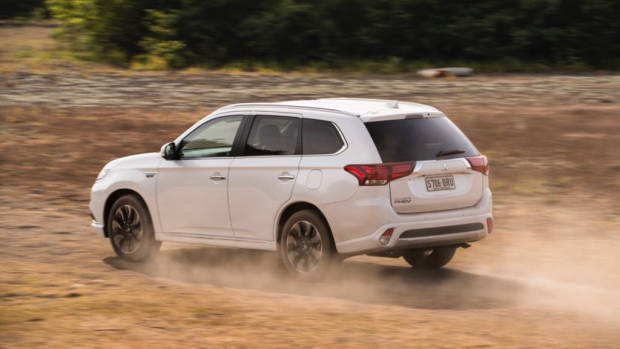
Key specs (as tested)
About Chasing cars
Chasing Cars reviews are 100% independent.
Because we are powered by Budget Direct Insurance, we don’t receive advertising or sales revenue from car manufacturers.
We’re truly independent – giving you Australia’s best car reviews.
The estimate provided does not take into account your personal circumstances but is intended to give a general indication of the cost of insurance, in order to obtain a complete quote, please visit www.budgetdirect.com.au. Estimate includes 15%^ online discount.
^Conditions Apply
Budget Direct Insurance arranged by Auto & General Services Pty Ltd ACN 003 617 909(AGS) AFSL 241 411, for and on behalf of the insurer, Auto & General Insurance Company Limited(ABN 42 111 586 353, AFSL 285 571).Because we don’t know your financial needs, we can’t advise you if this insurance will suit you. You should consider your needs and the Product Disclosure Statement before making a decision to buy insurance. Terms and conditions apply.
Indicative quote based on assumptions including postcode , 40 year old male with no offences, licence suspensions or claims in the last 5 years, a NCD Rating 1 and no younger drivers listed. White car, driven up to 10,000kms a year, unfinanced, with no modifications, factory options and/or non-standard accessories, private use only and garaged at night.
^Online Discounts Terms & Conditions
1. Discounts apply to the premium paid for a new Budget Direct Gold Comprehensive Car Insurance, Third Party Property Only or Third Party Property, Fire & Theft Insurance policy initiated online on or after 29 March 2017. Discounts do not apply to optional Roadside Assistance.
2. Discounts do not apply to any renewal offer of insurance.
3. Discounts only apply to the insurance portion of the premium. Discounts are applied before government charges, taxes, levies and fees, including instalment processing fees (as applicable). The full extent of discounts may therefore be impacted.
4. We reserve the right to change the offer without notice.